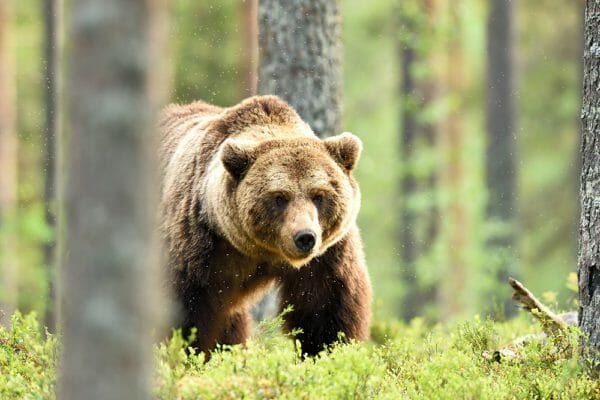
During a crisp early Wednesday morning on October 15, 2003, near Fortine, Montana, James Beeman used a .410 shotgun to shoot and drop a charging grizzly bear at three feet.
James Beeman had been having problems with raccoons in the large chicken coop he had built, about 50 yards from his 3600 square foot home. At about 3:30 a.m., he heard an unusual noise, sort of a mew-mew, but he did not sense anything amiss. At 4:30 a.m., chaos erupted in the chicken coop.
The coop was 36×22 feet, with a floor 4 feet above ground level to allow the chicken droppings to fall to the ground for easy cleaning. It housed 250 chickens. A ramp ran up into the coop to allow access.
James was dressed in longjohn underwear. He got up and started to grab a 12 gauge shotgun. Thinking the disturbance was caused by raccoons, and not wanting to damage his chickens or coop more than necessary, he grabbed a .410 bolt action shotgun instead. The shotgun held three rounds of #7.5 bird shot. James put on footgear and a earflap hat. He had a headlamp on as he walked to the door of the chicken coop.
He was only a few feet away when he saw a bear cub had its head inside the coop. The cub looked at him and took off away from the coop toward a fenced dead end. A second cub appeared and took off in the same direction. The big bear stuck its head out of the coop. It was only three feet from where James was standing. It had a chicken in its mouth. The bear dropped the chicken and “woofed.” James was starting to back up. It had rained a little during the night. The ground showed James backed up seven steps as the bear jumped down and off the ramp, breaking off a corner of a 1″ plywood sheet. She came at James from 15 feet. He fired from the hip when the bear was three feet from the muzzle of the .410. The bear dropped at his feet.
James called the authorities. The game warden showed up two hours later. It was still dark. The bear’s eyes glowed red, and James thought it might still be alive. The warden said: “no, the eyes would be glowing green if the bear was alive.”
The entrance wound was 2 centimeters or 3/4 of an inch left of the right nostril, centered on the nose.
The warden used a foot-long stick to follow the wound track. It penetrated back to where the brain was expected to be. In the necropsy, two #7.5 pellets were found in the brain, killing the bear. The rest of the shot charge had cleared the way for those two pellets to penetrate the brain.
The necropsy measured the bear at 580 lbs. The big sow had 22 tattoos from being captured previously. Each time she had been captured, she got another tattoo. The sow had come down from Canada and was believed to be 18-20 years old.
James revealed bears are a common problem in the area. No food can be left outside. People who need to protect stock, chickens, or other things bears like to eat, such as honey in beehives, are forced to use electric fences. This correspondent considers electric fences to be a nuisance to deal with. However, they protect against bears better and more cheaply than non-electric barriers. The fences are turned off in the winter, when bears hibernate.
The bear cubs were captured. As cubs of the year, it did not seem likely they would survive the winter. They were placed in an old den.
When people had stock on the frontier, they protected the stock by hunting down stock killing bears and killing the bears. Bears soon learned to stay away from humans in order to survive.
Not long ago, James had another problem with a bear visit. It was captured, and a DNA sample was taken. The DNA showed it was descended from the female cub of the bear James had killed in 2003.
Sows with bad habits pass on the bad habits to their cubs.
As the Myth of Old Groaner in Alaska grew, the writer who embellished the original tale claimed a .410 was useless against grizzly bears. The case of James Beeman in 2003 shows a .410 is much better than a sharp stick. Even a 2 1/2 inch .410 with a half ounce of shot at 1300 fps, is about the same energy as a .44 magnum. To penetrate much, the shot has to be delivered in a compact mass. It has spread out too much by five yards. At one yard, it was sufficient.
Several bears have been killed with birdshot at ranges of less than 15 feet. A bigger shot probably works better.
About Dean Weingarten:
Dean Weingarten has been a peace officer, a military officer, was on the University of Wisconsin Pistol Team for four years, and was first certified to teach firearms safety in 1973. He taught the Arizona concealed carry course for fifteen years until the goal of Constitutional Carry was attained. He has degrees in meteorology and mining engineering, and retired from the Department of Defense after a 30 year career in Army Research, Development, Testing, and Evaluation.
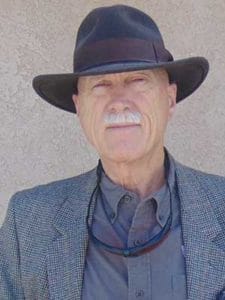

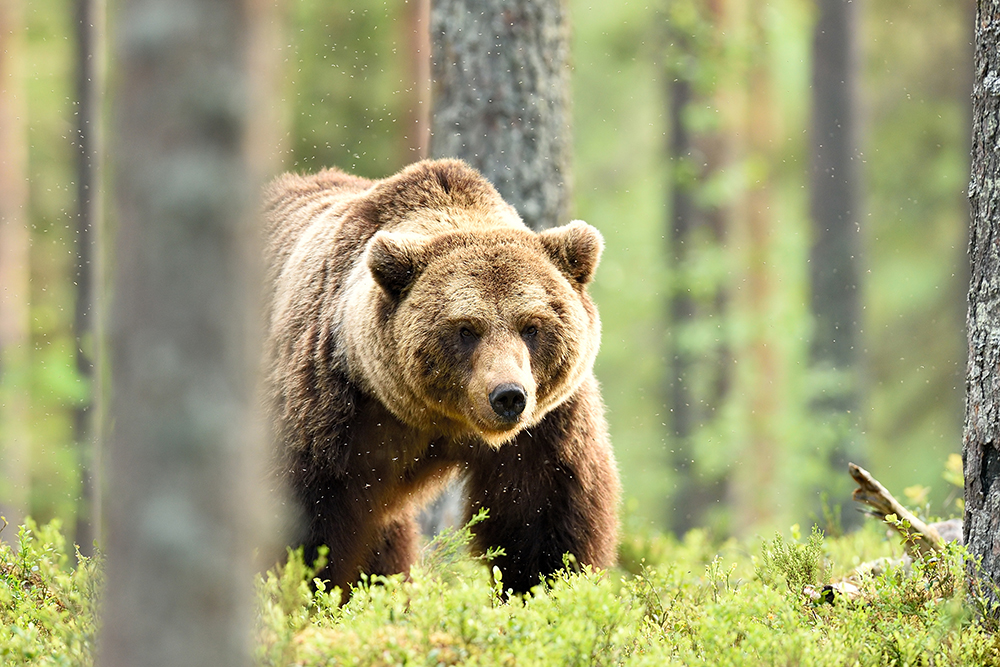
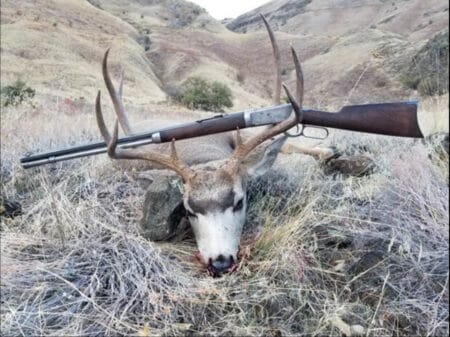


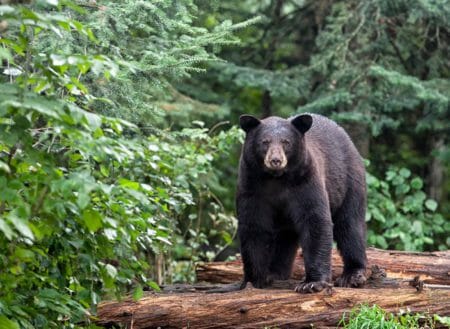
Note to self: When shooting grizzly bear with a .410 at a range of 3 feet, pack an extra pair of drawers and a dozen Sani-Wipes.
Two 7.5 shot pellets to the brain is a very slim margin for safety or life! This guy needs to buy a lotto ticket, test fly a space ship and hand tag a white shark. Providence, not luck or proper choice of weapons or purposeful/proper shot placement, is what happened here.
Be prepared. Bring enough gun. Hope for the best but plan for the worst. Be aware of your surroundings.
Good job Dean
Arm up and carry on
There is good reason that all firearms are considered deadly weapons.
The first rule of a gun fight is to have a gun.
Firearms are the great equalizer.
When they say bird shot isn’t effective for home defense
And no it might not be first choice however….
I have horse-friendly electrified braided rope fencing. It’s always kept the black bear out of the pastures. I’ve seen them on camera look at the fencing and turn around to avoid it.
Thanks Dean. Your Bear series are the most informative and influential reference documents that have ever been assembled, IMHO. Your series should award you a Pulitzer or some other high achievement award.
Do you have plans on grouping these articles in a hard bound set of volumes? They deserve it.
I believe this one is one of your most informative installments yet. Thanks again.
Thank you, Dean. I never would have believed a .410 could have killed a griz.
He got very lucky and I would not want to use a 410 for defense against a grizzley bear . That’s why I do not own a 410 and a 20 gauge is the minimum at my house .
“The big sow had 22 tattoos from being captured previously.” Possibly an extremely interesting article. How many times is the average bear tattooed ? … Is there “symbolism” to the “tattoo’s design” and placement ? … Can a bear have too many tats ? Do some bears seek out tattoos to document their travels ? … Do tattooed bears have better stories than bears without ? Does a bear without listening to the stories of one with 22 tattoos just “grin” ? … Is that genesis of “grin and bare” ? Or, is it conservation officers who consider bears a… Read more »
This reminds me of my hunting adventure when I was 8 years old on my Grandfather’s Dairy farm in Northern Wisconsin. My brothers were all busy, my Dad and 2 Uncles were helping my Grandpa work on a broken auger in the barn. So, I decided to brave it and go out on my own to hunt rabbits and squirrels with my single shot .22. My Dad, who was a stickler for gun safety, made sure I only had 5 rounds with me in my pocket, my boots were laced up properly and described my limits for wandering around. After… Read more »